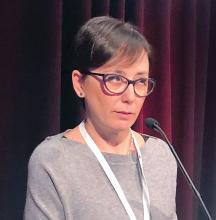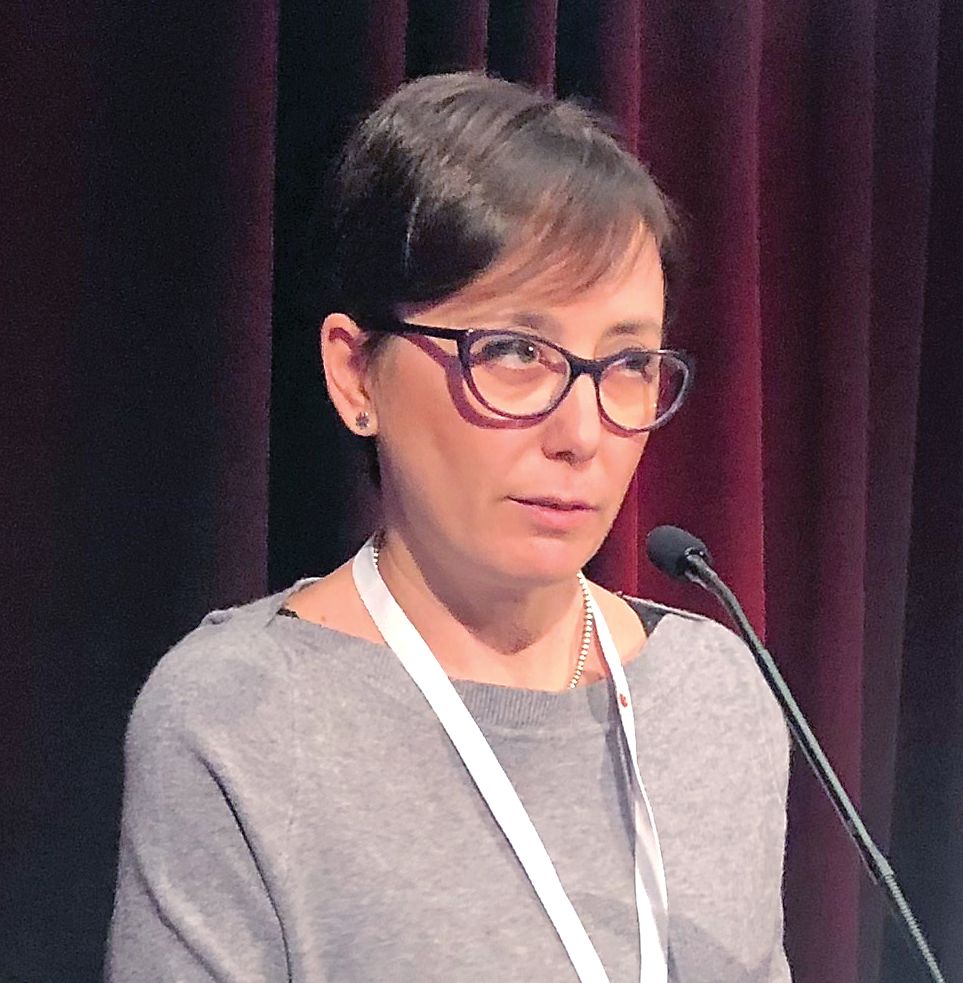User login
SAN DIEGO – Switching to lenalidomide maintenance after nine cycles of lenalidomide/dexamethasone (Rd) may avoid toxicity without sacrificing survival benefit in elderly multiple myeloma patients of intermediate fitness, results from a randomized trial showed.
The Rd-R strategy yielded a “slight improvement” in event-free survival due largely to fewer adverse events, and no significant differences in progression-free or overall survival versus continuous Rd, reported Alessandra Larocca, MD, of GIMEMA/European Myeloma Network in Italy.
That finding suggests the promise of adapting myeloma treatment to a patient’s level of frailty or fitness, as determined by a myeloma frailty score, Dr. Larocca said at the annual meeting of the American Society of Hematology.
“A frailty-adjusted treatment approach is important in intermediate-fit patients to balance efficacy and safety,” she said.
The frailty score, developed by the International Myeloma Working Group (IMWG), classifies individuals as fit, intermediate, or frail based on age, comorbidities, cognitive status, and functional status. In a 2015 report in Blood, the IMWG frailty score was shown to predict mortality and treatment-related toxicity in elderly myeloma patients.
Dr. Larocca described results of the RV-MM-PI-0752 phase 3 study, which enrolled 199 newly diagnosed myeloma patients of intermediate fitness and randomized them to continuous Rd or nine cycles of Rd induction followed by lenalidomide maintenance (Rd-R).
The goal was to see if Rd could be “further optimized” for elderly, intermediate-fit patients, Dr. Larocca said.
The primary endpoint of RV-MM-PI-0752 was event-free survival, which included grade 4 hematologic and grade 3-4 nonhematologic adverse events, lenalidomide discontinuation, disease progression, or death.
Median event-free survival was 9.3 months for the Rd-R strategy, compared with 6.6 months for continuous Rd (hazard ratio, 0.72; 95% confidence interval, 0.52-0.99; P = .044), Dr. Larocca reported.
No difference was seen in survival outcomes, she added. The 20-month progression-free survival was 43% and 42% for Rd-R and continuous Rd, respectively. The 20-month overall survival was 84% vs. 79%, with P values that were not significant for either comparison.
Patients in the Rd-R group had a somewhat higher incidence of grade 3 or greater neutropenia, but the continuous Rd group had a somewhat higher rate of nonhematologic adverse events, leading to slightly higher rates of lenalidomide discontinuation and dose reduction, Dr. Larocca said.
Overall, 9% of patients dropped out of the RV-MM-PI-0752 trial within the first 60 days, due mainly to toxicity, she added.
“We have to evaluate how to better prevent toxicity, potentially enabling patients to stay on therapy longer,” Dr. Larocca said. “Probably we have to evaluate, in prospective clinical trials, the role of up-front dose adjustment or dose reduction, and subsequent dose increase in a subgroup of patients.”
Dr. Larocca reported disclosures related to Celgene, Bristol-Myers Squibb, Janssen-Cilag, Takeda, and Amgen.
SOURCE: Larocca A, et al. ASH 2018, Abstract 305.
SAN DIEGO – Switching to lenalidomide maintenance after nine cycles of lenalidomide/dexamethasone (Rd) may avoid toxicity without sacrificing survival benefit in elderly multiple myeloma patients of intermediate fitness, results from a randomized trial showed.
The Rd-R strategy yielded a “slight improvement” in event-free survival due largely to fewer adverse events, and no significant differences in progression-free or overall survival versus continuous Rd, reported Alessandra Larocca, MD, of GIMEMA/European Myeloma Network in Italy.
That finding suggests the promise of adapting myeloma treatment to a patient’s level of frailty or fitness, as determined by a myeloma frailty score, Dr. Larocca said at the annual meeting of the American Society of Hematology.
“A frailty-adjusted treatment approach is important in intermediate-fit patients to balance efficacy and safety,” she said.
The frailty score, developed by the International Myeloma Working Group (IMWG), classifies individuals as fit, intermediate, or frail based on age, comorbidities, cognitive status, and functional status. In a 2015 report in Blood, the IMWG frailty score was shown to predict mortality and treatment-related toxicity in elderly myeloma patients.
Dr. Larocca described results of the RV-MM-PI-0752 phase 3 study, which enrolled 199 newly diagnosed myeloma patients of intermediate fitness and randomized them to continuous Rd or nine cycles of Rd induction followed by lenalidomide maintenance (Rd-R).
The goal was to see if Rd could be “further optimized” for elderly, intermediate-fit patients, Dr. Larocca said.
The primary endpoint of RV-MM-PI-0752 was event-free survival, which included grade 4 hematologic and grade 3-4 nonhematologic adverse events, lenalidomide discontinuation, disease progression, or death.
Median event-free survival was 9.3 months for the Rd-R strategy, compared with 6.6 months for continuous Rd (hazard ratio, 0.72; 95% confidence interval, 0.52-0.99; P = .044), Dr. Larocca reported.
No difference was seen in survival outcomes, she added. The 20-month progression-free survival was 43% and 42% for Rd-R and continuous Rd, respectively. The 20-month overall survival was 84% vs. 79%, with P values that were not significant for either comparison.
Patients in the Rd-R group had a somewhat higher incidence of grade 3 or greater neutropenia, but the continuous Rd group had a somewhat higher rate of nonhematologic adverse events, leading to slightly higher rates of lenalidomide discontinuation and dose reduction, Dr. Larocca said.
Overall, 9% of patients dropped out of the RV-MM-PI-0752 trial within the first 60 days, due mainly to toxicity, she added.
“We have to evaluate how to better prevent toxicity, potentially enabling patients to stay on therapy longer,” Dr. Larocca said. “Probably we have to evaluate, in prospective clinical trials, the role of up-front dose adjustment or dose reduction, and subsequent dose increase in a subgroup of patients.”
Dr. Larocca reported disclosures related to Celgene, Bristol-Myers Squibb, Janssen-Cilag, Takeda, and Amgen.
SOURCE: Larocca A, et al. ASH 2018, Abstract 305.
SAN DIEGO – Switching to lenalidomide maintenance after nine cycles of lenalidomide/dexamethasone (Rd) may avoid toxicity without sacrificing survival benefit in elderly multiple myeloma patients of intermediate fitness, results from a randomized trial showed.
The Rd-R strategy yielded a “slight improvement” in event-free survival due largely to fewer adverse events, and no significant differences in progression-free or overall survival versus continuous Rd, reported Alessandra Larocca, MD, of GIMEMA/European Myeloma Network in Italy.
That finding suggests the promise of adapting myeloma treatment to a patient’s level of frailty or fitness, as determined by a myeloma frailty score, Dr. Larocca said at the annual meeting of the American Society of Hematology.
“A frailty-adjusted treatment approach is important in intermediate-fit patients to balance efficacy and safety,” she said.
The frailty score, developed by the International Myeloma Working Group (IMWG), classifies individuals as fit, intermediate, or frail based on age, comorbidities, cognitive status, and functional status. In a 2015 report in Blood, the IMWG frailty score was shown to predict mortality and treatment-related toxicity in elderly myeloma patients.
Dr. Larocca described results of the RV-MM-PI-0752 phase 3 study, which enrolled 199 newly diagnosed myeloma patients of intermediate fitness and randomized them to continuous Rd or nine cycles of Rd induction followed by lenalidomide maintenance (Rd-R).
The goal was to see if Rd could be “further optimized” for elderly, intermediate-fit patients, Dr. Larocca said.
The primary endpoint of RV-MM-PI-0752 was event-free survival, which included grade 4 hematologic and grade 3-4 nonhematologic adverse events, lenalidomide discontinuation, disease progression, or death.
Median event-free survival was 9.3 months for the Rd-R strategy, compared with 6.6 months for continuous Rd (hazard ratio, 0.72; 95% confidence interval, 0.52-0.99; P = .044), Dr. Larocca reported.
No difference was seen in survival outcomes, she added. The 20-month progression-free survival was 43% and 42% for Rd-R and continuous Rd, respectively. The 20-month overall survival was 84% vs. 79%, with P values that were not significant for either comparison.
Patients in the Rd-R group had a somewhat higher incidence of grade 3 or greater neutropenia, but the continuous Rd group had a somewhat higher rate of nonhematologic adverse events, leading to slightly higher rates of lenalidomide discontinuation and dose reduction, Dr. Larocca said.
Overall, 9% of patients dropped out of the RV-MM-PI-0752 trial within the first 60 days, due mainly to toxicity, she added.
“We have to evaluate how to better prevent toxicity, potentially enabling patients to stay on therapy longer,” Dr. Larocca said. “Probably we have to evaluate, in prospective clinical trials, the role of up-front dose adjustment or dose reduction, and subsequent dose increase in a subgroup of patients.”
Dr. Larocca reported disclosures related to Celgene, Bristol-Myers Squibb, Janssen-Cilag, Takeda, and Amgen.
SOURCE: Larocca A, et al. ASH 2018, Abstract 305.
REPORTING FROM ASH 2018
Key clinical point:
Major finding: Median event-free survival was 9.3 months for the Rd induction followed by lenalidomide maintenance, compared with 6.6 months for continuous Rd (P = .044).
Study details: Results of the RV-MM-PI-0752 phase 3 study, which enrolled 199 newly diagnosed multiple myeloma patients of intermediate fitness.
Disclosures: Dr. Larocca reported disclosures related to Celgene, Bristol-Myers Squibb, Janssen-Cilag, Takeda, and Amgen.
Source: Larocca A et al. ASH 2018, Abstract 305.

